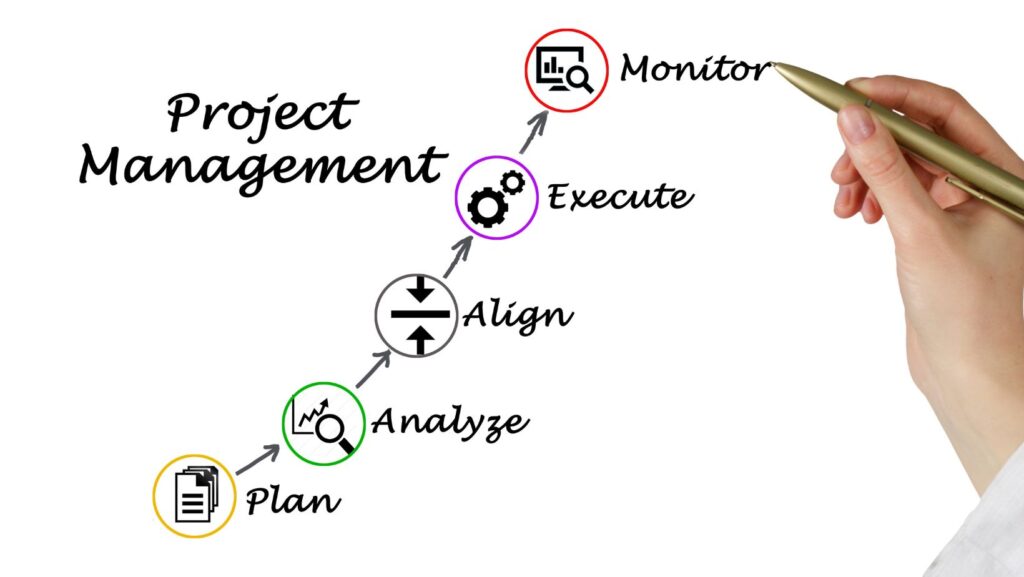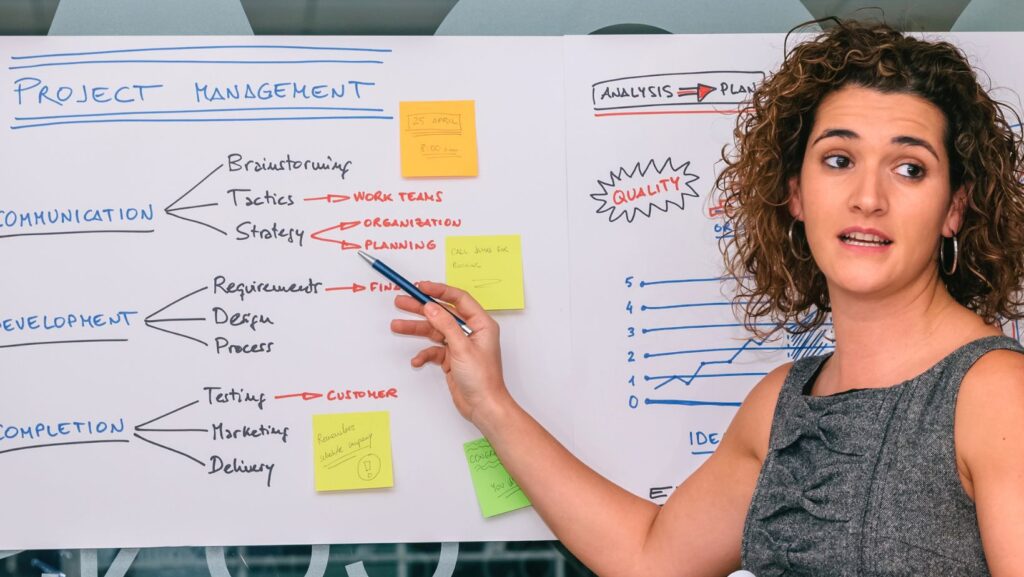Project Management: 7+ Techniques For Your Home or Small Business

Are you a stay-at-home mom who has successfully launched a home-based venture while juggling other family responsibilities? Or maybe you are a busy professional with a regular 9-5 and built your side hustle.
Whatever your business is, we know that running a part-time or home-based business demands exceptional time management, organization, and unwavering dedication.
Let us introduce you to the secret sauce for success – classic project management techniques!
By breaking down complex projects into smaller, more manageable tasks and crafting a strategic plan to accomplish them systematically, project management can be your ultimate game-changer.
Join us in this blog post as we dive deep into the world of project management and demonstrate how you, too, can unleash its power in your journey to home business success.
Stay tuned, and let’s skyrocket your productivity and efficiency together!
Identify Your Projects

The first step in applying project management techniques to your home business is to identify the projects that you need to complete. These may include tasks such as developing a marketing plan, creating a new product or service, or redesigning your website.
Once you have identified your projects, you can then break them down into smaller tasks or deliverables.
Breaking down your projects into smaller tasks or deliverables helps to make the work more manageable, easier to prioritize and prevent burn out. You can also assign tasks to team members if applicable, or schedule them in a way that makes sense for your workload.
Project Management Methodologies

Before diving into creating a project plan, it’s important to understand various project management methodologies that can be applied to your home-based business.
Some popular methodologies include Agile, Scrum, Kanban, and Waterfall. Each has its advantages and can be adapted to suit your business needs.
Agile methodologies, like Scrum or Kanban, can be especially helpful for businesses with rapidly changing priorities or product requirements, while the Waterfall method can work well for more linear projects with clear milestones.
Agile
Agile is a flexible and iterative project management approach that emphasizes collaboration, customer feedback, and rapid adaptation to change.
- Instead of following a linear process, Agile projects progress through a series of iterations called sprints, which typically last 2-4 weeks.
- At the end of each sprint, the team reviews the work completed and adjusts their plan based on feedback and any new information.
- Agile is particularly well-suited for projects with uncertain or changing requirements, such as software development.
Scrum
Scrum is a specific Agile framework that focuses on delivering small, incremental improvements in a time-boxed manner.
- In Scrum, a cross-functional team works together to complete a set of prioritized tasks within each sprint.
- The team is self-organizing, with a Scrum Master facilitating the process and ensuring the team follows the Scrum framework.
- Regular meetings, such as daily stand-ups, sprint planning, sprint review, and sprint retrospective, help the team maintain alignment, adapt to changes, and continuously improve their process.
Kanban
Another Agile style that focuses on visualizing work, restricting work in progress (WIP), and managing workflow to increase productivity is Kanban.
- In Kanban, a team uses a visual board (physical or digital) divided into columns representing different stages of the work process. Tasks are represented by cards, which are moved through the columns as they progress.
- By limiting the number of tasks in each column, the team can focus on completing work more efficiently and identify bottlenecks in the process.
- Kanban is well-suited for projects with a continuous flow of work, such as maintenance or support tasks.
Waterfall
Waterfall is a traditional, linear project management methodology where each phase of the project is completed sequentially before moving on to the next.
- The process starts with requirements gathering, followed by design, implementation, testing, deployment, and maintenance.
- The Waterfall approach relies on thorough planning and accurate estimates, as changes or revisions can be challenging and costly to implement once the project has moved beyond the early stages.
- Waterfall is best suited for projects with well-defined requirements and little likelihood of significant changes during the project’s lifecycle.
Each of these methodologies has its strengths and weaknesses, and the best choice will depend on the specific needs and requirements of your project.
Agile methodologies like Scrum and Kanban are better suited for projects with changing requirements, while Waterfall is more appropriate for projects with a stable, well-defined scope.
Create a Project Plan

Once you have identified your projects and broken them down into smaller tasks or deliverables, the next step is to create a project plan.
This plan should include a list of all the tasks or deliverables that need to be completed, along with deadlines and milestones.
You should also allocate resources, such as time, money, and personnel (even if it is just yourself), to each task.
When creating your project plan, be sure to consider any potential roadblocks or challenges that may arise.
Example: You are developing a new product, you may need to account for delays in production or supply chain disruptions. By planning for potential challenges, you can be better prepared to address them if they occur.
Tools and Technologies for Project Management
There are various tools and technologies available that can help streamline project management tasks for home-based businesses.
Project management software like Trello, Asana, and Basecamp can help you stay organized, while communication tools like Slack and video conferencing apps can help you stay connected with your team members.
Choosing the right tools can enhance your project management capabilities and make it easier to track progress, collaborate, and communicate with your team.
Regularly Review Your Project Plan
To ensure that you stay on track, you should regularly review your project plan and update it as needed.
This means reviewing the tasks and deliverables, deadlines, and resource allocation to ensure that you are making progress as planned.
If you find that you are falling behind schedule or have encountered unexpected challenges, you may need to adjust your project plan.
This may involve re-prioritizing tasks or allocating additional resources to certain tasks to ensure that they are completed on time.
Track Your Progress

In addition to regularly reviewing your project plan, you should also track your progress against your plan.
This involves monitoring your work and the work of any team members to ensure that you are on schedule and within budget.
There are many free tools and software applications available to help you track your progress, such as project management software or spreadsheets.
By regularly tracking your progress, you can identify any potential issues early on and take corrective action to keep your project on track.
Manage Risk
Another important aspect of project management is risk management. This involves identifying potential risks and developing a plan to mitigate them.
If you are developing a new product, you may want to identify potential risks such as supply chain disruptions or production delays and develop a contingency plan to address these risks if they occur.
Effective risk management involves being proactive and anticipating potential issues before they occur.
Identifying potential risks and developing contingency plans, you can be better prepared to handle unexpected challenges.
Communicate Effectively

Communication is also an important aspect of project management. You should ensure that everyone involved in the project is aware of their responsibilities and is kept up to date on progress.
You should also hold regular meetings (if you have more than 1 employee besides yourself) to discuss any issues or concerns and to ensure that everyone is on the same page.
Effective communication is essential for ensuring that your project stays on track and that everyone is working towards the same goal.
It also helps to ensure that any issues or concerns are addressed early on, before they become bigger problems.
Motivate Your Team
Motivating your team is another important aspect of project management.
This involves ensuring that everyone is engaged and working towards the same goal, and means providing support and encouragement to team members to keep them motivated and focused.
One way to motivate your team is to set clear expectations and goals from the outset.
This helps to ensure that everyone is working towards the same goal and understands what is expected of them.
If you are a solo business owner, I’d recommend you tune into books. Books are a great way to keep yourself motivated, informed and educated.
If you are short on time, use book summary apps like Blinkist or Headway( Apple or Google) to skim through multiple books in a short time.
Collaborate Effectively

Effective collaboration is also important for successful project management. This involves working together with team members to achieve a common goal.
It also means being open to feedback and suggestions from team members to ensure that everyone’s ideas are heard and considered.
Collaboration can be challenging when working remotely or from home.
There are many tools and technologies available to help you collaborate effectively, such as project management software, video conferencing, and online chat tools.
Project Management Software
- Trello
- Asana
- Basecamp
- Monday.com
- ClickUp
- Smartsheet
- Microsoft Project
Video Conferencing Tools
Online Chat Tools
Measure Success
Measuring success is an important aspect of project management. This involves tracking metrics and key performance indicators (KPIs) to determine whether you have achieved your goals.
There are many metrics and KPIs that you can track, depending on the nature of your project.
Example: If you are developing a new product, you may track sales figures, customer feedback, or market share.
Final Thoughts
Implementing project management techniques to your home business will help you successfully manage your workload, remain on track, and achieve your goals.
You can ensure that your projects are completed on schedule and under budget by breaking large projects down into smaller tasks, developing a project plan, and allocating resources.
You may minimize potential challenges and increase your chances of success by routinely monitoring your progress, controlling risks, communicating effectively, motivating your team, collaborating successfully, and measuring success.
Adopting these project management approaches will assist you in propelling your home business to new levels of production and efficiency.
Bio:

Ronnie Patterson
Ronnie Patterson, founder of MagnÜron, is a multifaceted entrepreneur with a diverse background in music, electronics engineering, and engineering management. Drawing on experience across various industries, He offers expertise in SEO, operations, and strategy to help businesses thrive. Possessing a unique perspective and unwavering commitment to collaboration, and ideal partner for growth and success.






